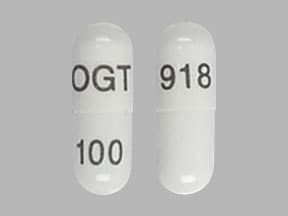Dosage Forms
Excipient information presented when available (limited, particularly for generics); consult specific product labeling.
Capsule, Oral:
Zavesca: 100 mg [contains soybean lecithin]
Generic: 100 mg
Pharmacology
Mechanism of Action
Miglustat competitively and reversibly inhibits the enzyme needed to produce glycosphingolipids and decreases the rate of glycosphingolipid glucosylceramide formation. Glucosylceramide accumulates in type 1 Gaucher disease, causing complications specific to this disease.
Pharmacokinetics/Pharmacodynamics
Distribution
Vd: 83-105 L
Metabolism
No evidence of metabolism in humans
Excretion
Urine (as unchanged drug)
Time to Peak
Plasma: 2-2.5 hours
Half-Life Elimination
6-7 hours
Protein Binding
No binding to plasma proteins
Use in Specific Populations
Special Populations: Renal Function Impairment
Limited data suggests that the clearance of miglustat decreases 40% and 60% with mild and moderate renal impairment, respectively. A decreased clearance of 70% has been suggested in patients with severe renal impairment.
Use: Labeled Indications
Gaucher disease: Treatment of adult patients with mild-to-moderate type 1 Gaucher disease for whom enzyme replacement therapy is not a therapeutic option (eg, due to allergy, hypersensitivity, or poor venous access)
Use: Off Label
Niemann-Pick Type C diseasecyes
Data from a randomized, controlled trial supports the use of miglustat in the treatment of Niemann-Pick Type C disease. Additional trials may be necessary to further define the role of miglustat in this condition Patterson 2007.
Based on the Niemann-Pick Type C Guidelines Working Group, miglustat is an effective and recommended treatment option in the management of existing neurologic manifestations of Niemann-Pick Type C disease Patterson 2012.
Contraindications
There are no contraindications listed in the manufacturer’s labeling.
Canadian labeling: Hypersensitivity to miglustat or any component of the formulation; women who are or may become pregnant
Dosage and Administration
Dosing: Adult
Type 1 Gaucher disease: Oral: 100 mg 3 times daily; dose may be reduced to 100 mg 1 to 2 times daily in patients with adverse effects (ie, tremor, diarrhea)
Niemann-Pick Type C disease (off-label use) Oral: 200 mg 3 times daily (Patterson 2007; Santos-Lozano 2015)
Dosing: Geriatric
Refer to adult dosing.
Dosing: Pediatric
Niemann-Pick Type C disease: Limited data available (Heron 2012; Patterson 2012): Note: Therapy is recommended for patients with neurological, cognitive, or psychiatric disease manifestations (Patterson 2012). Infant data is very limited; reported infant neurological effects (aside from seizures) have included hypotonia, dysphagia, feeding difficulties (onset: 5 to 12 months of age); earliest reported miglustat therapy is 7 months of age (DiRoccoa 2012; Heron 2012). Doses may be initiated slowly and adjusted for tolerability, particularly GI effects (diarrhea which may require dietary and pharmacologic management (Heron 2012; Patterson 2012). Several months of therapy may be necessary to see clinical benefit (eg, 6 to 12 months) (Patterson 2012).
Infants and Children <12 years: Oral:
BSA ≤0.47 m2: 100 mg once daily
BSA >0.47 to 0.73 m2: 100 mg twice daily
BSA >0.73 to 0.88 m2: 100 mg 3 times daily
BSA >0.88 to 1.25 m2: 200 mg twice daily
BSA >1.25 m2: 200 mg 3 times daily
Children ≥12 years and Adolescents: 200 mg 3 times daily (Zavesca prescribing information [Canada 2012]; Zavesca prescribing information [European Medicines Agency 2012])
Administration
May be administered with or without food; administration between meals may decrease the incidence of diarrhea. Capsules should be taken at the same time each day at regular intervals. If patient is unable to tolerate or swallow capsule whole and powder is administered, mix powder into a liquid immediately prior to use (do not store); sweetening agents are not expected to interact (data on file [Actelion Pharmaceuticals Ltd, 2011])
Dietary Considerations
Patients with diarrhea should avoid foods with high carbohydrate content.
Storage
Store at 20°C to 25°C (68°F to 77°F). Brief exposure to 15°C to 30°C (59°F to 86°F) permitted. Note: Extended storage information may be available; contact product manufacturer to obtain current recommendations.
Miglustat Images
Drug Interactions
There are no known significant interactions.
Adverse Reactions
Percentages reported from open-label, uncontrolled monotherapy trials.
>10%:
Central nervous system: Headache (21% to 22%), dizziness (≤11%)
Endocrine & metabolic: Weight loss (39% to 67%)
Gastrointestinal: Diarrhea (89% to 100%), abdominal pain (18% to 67%), flatulence (29% to 50%), nausea (8% to 22%), vomiting (4% to 11%)
Neuromuscular & skeletal: Tremor (11% to 30%), weakness (17%), leg cramps (4% to 11%)
Ophthalmic: Visual disturbance (≤17%)
1% to 10%:
Central nervous system: Memory impairment (8%), unsteady gait (8%), paresthesia (≤7%), migraine (≤6%)
Endocrine & metabolic: Menstrual disease (≤6%)
Gastrointestinal: Abdominal distension (8%), constipation (8%), xerostomia (8%), anorexia (≤7%), dyspepsia (≤7%), bloating (≤6%), epigastric pain (≤6%)
Hematologic & oncologic: Thrombocytopenia (6% to 7%)
Neuromuscular & skeletal: Back pain (8%)
Warnings/Precautions
Concerns related to adverse effects:
- Diarrhea: Observed in the majority of patients, many also reported weight loss (within first 12 months of treatment). Diarrhea decreased over time with continued treatment, and may respond to diet modification (eg, reduction of sucrose, lactose and other carbohydrate intake), taking miglustat between meals, and/or to anti-diarrheal medications. If diarrhea occurs during treatment, instruct patients to avoid foods with high carbohydrate content. If symptoms persist, evaluate patients for underlying GI disease.
- Peripheral neuropathy: Peripheral neuropathy has been reported; neurologic monitoring is required. Weigh risk versus benefit of therapy if patient develops symptoms (eg, numbness and tingling); treatment discontinuation may be necessary.
- Platelet counts decreased: Mild decrease in platelet counts (without bleeding) has been observed in patients with type 1 Gaucher disease switched from enzyme replacement therapy; monitor platelet counts during therapy.
- Tremor: New-onset or exacerbations of existing tremor may occur. Tremor typically begins within the first month of treatment and may resolve over time (1-3 months) or respond to dosage reduction. Treatment discontinuation may be necessary if tremor does not respond within days of dose reduction.
Disease-related concerns:
- Renal impairment: Use with caution in patients with renal impairment; dosage adjustments recommended. Not recommended in patients with severe impairment.
Other warnings/precautions:
- Experienced physician: Should be administered under the supervision of a physician experienced in treatment of Gaucher disease.
- Registry: A registry has been established and all patients with Gaucher disease, and physicians who treat Gaucher disease are encouraged to participate. Information on the International Collaborative Gaucher Group (ICGG) Gaucher Registry may be obtained at https://www.registrynxt.com or by calling 1-888-404-4413.
Monitoring Parameters
Neurologic evaluations baseline and repeated every 6 months; adverse effects; weight; platelet count; renal function
Pregnancy
Pregnancy Risk Factor
C
Pregnancy Considerations
Adverse events were observed in animal reproduction studies.
Uncontrolled type 1 Gaucher disease is associated an increased risk of spontaneous abortion; maternal hepatosplenomegaly and thrombocytopenia may also occur and lead to adverse pregnancy outcomes.
Patient Education
- Discuss specific use of drug and side effects with patient as it relates to treatment. (HCAHPS: During this hospital stay, were you given any medicine that you had not taken before? Before giving you any new medicine, how often did hospital staff tell you what the medicine was for? How often did hospital staff describe possible side effects in a way you could understand?)
- Patient may experience dizziness, abdominal pain, heartburn, nausea, vomiting, passing gas, dry mouth, back pain, constipation, leg cramps, muscle cramps, lack of appetite, bloating, loss of strength and energy, weight loss, sensation of heaviness in extremities, or menstrual changes. Have patient report immediately to prescriber severe diarrhea, burning or numbness feeling, vision changes, bruising, bleeding, trouble with memory, severe headache, tremors, or abnormal gait (HCAHPS).
- Educate patient about signs of a significant reaction (eg, wheezing; chest tightness; fever; itching; bad cough; blue skin color; seizures; or swelling of face, lips, tongue, or throat). Note: This is not a comprehensive list of all side effects. Patient should consult prescriber for additional questions.
Intended Use and Disclaimer: Should not be printed and given to patients. This information is intended to serve as a concise initial reference for health care professionals to use when discussing medications with a patient. You must ultimately rely on your own discretion, experience, and judgment in diagnosing, treating, and advising patients.

